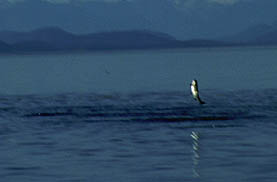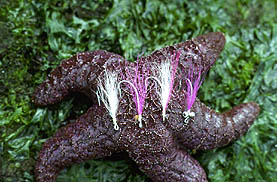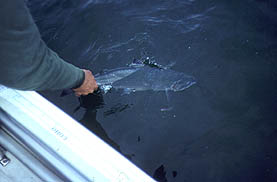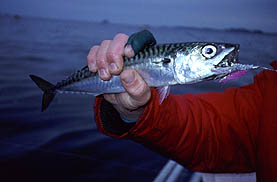
Saltwater Fly Fishing Series
"Saltwater Fly Fishing for Pacific Salmon"
with
Barry M. Thornton
|
|
|
A leaping 'Locator' salmon points to a school of fish for the fly fisher.
|
As I have become more experienced with salmon saltwater fly fishing, 3 decades now and still learning, I have come to realize that there are three distinct periods in the ocean phase of the life cyle of Pacific salmon when they can be consistently caught on a cast fly. These can best be divided into their three life-cycle stages as follows:
Stage 1:
The obvious first stage is open saltwater fly fishing for juvenile salmon, salmon that are in their first or second year in the ocean. These young fish are often called 'bluebacks' a regional term used for salmon under 5 pounds. Bluebacks can be either
coho
or
pink
salmon. Small
chinooks
in their early ocean years are often called 'jacks'. Bluebacks are often available for the fly fisher in vast surface rafts of fish in open water situations many miles from shore. Here the salmon feed on euphasiids, commonly know as 'pink feed' near the surface. Tide lines and flotsam often concentrate salmon in these April, May, and June periods and give the fly fisher a focus in what is a very large ocean. Flocks of gulls show anglers where these rafts swim or, single leaping 'locator' fish give away the location of these schools of fish. I have found it interesting to find pink and coho salmon schooling in the same areas at this time of the year.
Stage 2:
The second stage is open saltwater fishing for migrating maturing salmon that are homing on their natal stream. For the fly fisher, angling is done on shallow shoals, near kelp beds, or near shallow structure inshore at depths up to 40 feet. Beyond this depth it is difficult to sink a fly to where the salmon swim and feed. This is likely the most exciting time, for along the Pacific coast there are thousands and thousands of islands, fjords, shorelines and bays where these fish will concentrate for short but indefinite periods of time before they continue their homeward journey. This is the time for the hunter, the fly fisher who will travel and search, expecting no two days to be the same, but knowing that just beyond the next point of land there could be an incredible concentration of salmon just waiting for his cast fly.
|
|
|
Simple sleek flies with some pink are preferred flies for both 'estuary' and 'open ocean' salmon.
|
Stage 3:
The third and final stage is that which is best termed as full adult and is 'estuary' fly fishing. This is the time when salmon have completed their oceanic odyssey and have returned to their home estuary. They are full grown and their body chemistry is beginning to alter their shape, color, and inner organs in preparation for the final journey, up their home river to spawn. This is the time for active beach fly fishing for once they enter the river many cease to feed making river fishing for salmon a chance happening.
My decades of experiences have also allowed me to differentiate between the five Pacific salmon species. Each I have found is available at different times and in different circumstances. Chinook and coho are the recognized sports salmon of the Pacific coast. Without a doubt the chinook is the King of the Pacific salmon due to it's large size and deep dogged struggles when hooked. The coho on the other hand is the Prince of the Pacific salmon because of it's flashy surface battling struggles. Both are powerful fish that require angler patience and skill to boat. When fly fishing the shallows I have found that coho and chinook salmon can be hooked on a regular basis providing I am near active feeding salmon and that there is an obvious concentrated school of baitfish in the immediate area.
|
|
|
A careful release of this coho virtually ensures survival. Note the pink fly in the water nearby.
|
Pinks are the delicate salmon, much smaller than coho and chinook. But, what they lack in size they make up in spunky power. Pinks are the Princess of the sporting Pacific salmon. On their summer migration they become accessible to the fly fisher along coastal shorelines near home rivers. Fly fishers look for 'locator' pinks, that is leaping salmon that herald the appearance of schools of these feisty salmon. The other two species, sockeye and chum salmon, are not common targets of the fly fisher except at precise location and times. But, these latter two salmon have become the target of many fly fisher and it is exciting to know that some anglers have begun to perfect patterns in recent years that appear to interest some of these fish to strike.
Political interference has done much to disrupt the evolution of Pacific salmon as sports fish. Coho and chinook have only recently been allocated principally to the sports fishery, a move that has been applauded by many myself included. It will be interesting to see how Department of Fisheries management programs evolve to affect this positive move. But, regulations have been in effect since it seems forever, which prohibit sports fishers from targeting most salmon in fresh water. Some, but very limited, site specific regulations have allowed sports fishing for coho and chinook in fresh water streams but, pinks, sockeye and chum are rarely opened for sports fishers. This is tragic and it is a travesty of the use of a common resource. There is a vast surplus of chum, pinks and sockeye salmon in many B.C. watersheds, fish that could be the core of a salmon fresh water sports fishery which would ensure many stream guardians and a rich evolving recreational resource.
Saltwater Fly Fishing Tip:
|
|
|
The protective 'Peterson's Stripping Guard' is obvious on the index finger of this fly fisher as he shows a Pacific mackerel hooked on the west coast while salmon fly fishing.
|
I do a great deal of saltwater fly fishing and find that the minute grit that floats on the ocean surface acts like sandpaper on my stripping finger. Protection is a must for slow and fast retrieves which imitate crippled or escaping baitfish. However, the most serious problem occurs when a large salmon takes on one of the common smash hits. It is not possible to react quick enough to the fly lines streaming through your cinching finger with the result that a fine rope burn occurs - add salt - it becomes very painful. I now use a product called, "Peterson's Stripping Guards", which are sensitive lycra finger sleeves that protect your stripping fingers and save hugely on Band-Aides!
"The End"
©
Copyright Barry M. Thornton
Barry M. Thornton
| 






